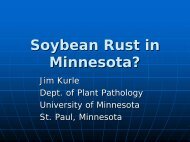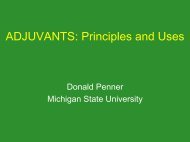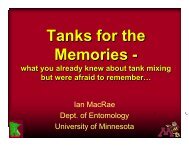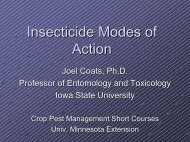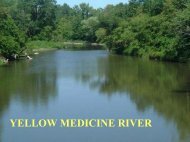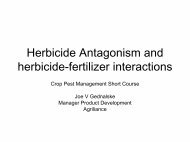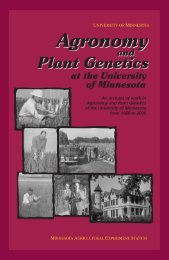Agronomy and Plant Genetics 100 Years No.2 - Department of ...
Agronomy and Plant Genetics 100 Years No.2 - Department of ...
Agronomy and Plant Genetics 100 Years No.2 - Department of ...
Create successful ePaper yourself
Turn your PDF publications into a flip-book with our unique Google optimized e-Paper software.
Willet Hays, Andrew Boss <strong>and</strong> an unknown personworking inside the Farm House.The Farm House being torn down (above).THE FARM HOUSEIn the fall <strong>of</strong> 1941, 23 students on a NationalYouth Administration project attended theschool <strong>of</strong> agriculture three days a week <strong>and</strong>worked three days on a project dismantlingthe Farm House piece by piece <strong>and</strong> salvagingall the lumber. Some <strong>of</strong> the lumber was usedby Don Harvey (an <strong>Agronomy</strong> plot worker) tobuild a house at 1965 North Clevel<strong>and</strong>Avenue in Roseville. This property is stilloccupied today.
ST. PAUL CAMPUS TODAY
1895Northwest Research& Outreach CenterCrookston1896Northcentral Research& Outreach CenterGr<strong>and</strong> Rapids1910West Central Research& Outreach CenterMorris1949Experimental Farm atRosemont (now part <strong>of</strong>U More Park)Rosemount1976S<strong>and</strong> Plain ExperimentalResearch FarmBeckerUniversity <strong>of</strong>Minnesota -St. Paul CampusH1912Southern Research &Outreach CenterWaseca1959Southwest Research& Outreach CenterLamberton
E.D. PORTERPr<strong>of</strong>essor E.D. Porter was hired by the Board <strong>of</strong> Regents in January 1981. He was the native <strong>of</strong> Vermont <strong>and</strong> a graduate<strong>of</strong> the University <strong>of</strong> Pennsylvania. He had held the Chair <strong>of</strong> Agriculture at Delaware College in Newark.With no students enrolled in agriculture, Porter was free to attend meetings <strong>of</strong> the state legislature <strong>and</strong> agriculturalorganizations to learn what they wanted in the way <strong>of</strong> agricultural programs. He conducted meetings for farmersthrough the Farmer’s Lecture courses which later became the Farmer Institutes <strong>and</strong> still later the Agricultural ExtensionDivision.In June, 1882, the Board <strong>of</strong> Regents purchased the Bass Farm <strong>of</strong> 155 acres in St. Anthony Park. The next fewyears were spent cleaning up the farml<strong>and</strong> <strong>and</strong> constructing the Farm House, Home Building, Barn, <strong>and</strong> anExperiment Station building.The second president <strong>of</strong> the U <strong>of</strong> MN, Cyrus Northrup, observed...In Minnesota there was a pr<strong>of</strong>essor <strong>of</strong> agriculture, a Farm House, a large barn, <strong>and</strong> a farmdevoted to agriculture <strong>and</strong> chemistry about 4 miles from the main campus. This pr<strong>of</strong>essor wasa good man, earnest, energetic, <strong>and</strong> enthusiastic, but he had little help. It was difficult to findqualified people because in no colleges could there be found men <strong>of</strong> sufficient knowledge in thevarious branches <strong>of</strong> agriculture to train students, <strong>and</strong> if such competent men could be found,they were already engaged <strong>and</strong> not interested in serving at an agricultural college.The Hatch Act passed in March, 1887, making $15,000/year available to the experimentstation. Porter soon used this money to bring together five men <strong>of</strong> such talents <strong>and</strong> abilitythat he soon was criticized for being less able than the new scientists he had just hired.Willet M. Hays was hired to conduct agricultural research <strong>and</strong> teach in the school.Porter soon responded to questions about education in agriculture by getting Board <strong>of</strong>Regents approval <strong>of</strong> a School <strong>of</strong> Agriculture which was neither a high school nor a collegebut a school whose primary focus was to bring as large a number <strong>of</strong> intelligent <strong>and</strong> ambitiousfarmer boys <strong>of</strong> agriculture, horticulture <strong>and</strong> allied industries. Students needed to beat least 15 years old <strong>and</strong> have a good common school education. Such was the start <strong>of</strong> theschool which operated from 1888 to 1960. Classes dealing with grain crops, forage crops,genetics, crop breeding, crop judging <strong>and</strong> farm management were taught by <strong>Agronomy</strong>faculty (Willet Hays, Andrew Boss, H.L. Thomas, E. Pinnell, L. Elling, C. Borgeson, H.K.Wilson, L. Bassett, A.C. Arny <strong>and</strong> J. Senz.)Porter resigned in March, 1889 to become Dean <strong>and</strong> Director <strong>of</strong> the College <strong>of</strong> Agriculture<strong>and</strong> Experiment Station at the University <strong>of</strong> Missouri.
Willet Hays addressing a group <strong>of</strong> field plot workers.WILLET HAYSWillet Hays began research <strong>and</strong> teaching at theUniversity <strong>of</strong> Minnesota in 1888 as an AssistantPr<strong>of</strong>essor. He was the first appointee made by E.D.Porter to the fledgling <strong>Department</strong> <strong>of</strong> Agriculture.He became Pr<strong>of</strong>essor in 1893. He resigned in 1905to become the Assistant Secretary <strong>of</strong> Agriculture.While with the department, Hays laid out thegeneral framework for the study <strong>of</strong> farmmanagement <strong>and</strong> conceived <strong>of</strong> the idea that thereare “Shakespeares” in plants, or plants with agenius strain, before the concept <strong>of</strong> heredity waswidely known.
ANDREW BOSSAndrew Boss was born in Wabasha County, Minnesota in 1867. At age 24 hegraduated in the second class (1891) <strong>of</strong> the School <strong>of</strong> Agriculture (a 2 year programat that time). Boss was chosen as the commencement speaker <strong>and</strong> a quotefrom his speech gives some insight into his views on the need for education, workexperience, attention to details <strong>and</strong> a positive attitude towards life.If we wish to be successful as farmers we must first obtain an education appropriateto the vocation, have some practical experience in field work, develop a habit <strong>of</strong> closeobservation <strong>and</strong> watchfulness, <strong>and</strong> last, but not least, a determined will to succeed.He was immediately hired as the experimental farm foreman by Willet Hays.Boss was actively involved in most aspects <strong>of</strong> the plant breeding program <strong>and</strong> veryearly saw the importance <strong>of</strong> the developing science <strong>of</strong> genetics to the improvement<strong>of</strong> crop plants <strong>and</strong> animals.He initiated pioneering studies <strong>of</strong> meats, including preparation, grading <strong>and</strong>proper application <strong>of</strong> these grades to live animal evaluation. He was responsiblefor construction <strong>and</strong> operation <strong>of</strong> the first abattoir at an educational institution inthe United States.Boss <strong>and</strong> W. Hays developed <strong>and</strong> taught courses in farm implements use,production <strong>and</strong> h<strong>and</strong>ling <strong>of</strong> hay <strong>and</strong> grain crops <strong>and</strong> farm management.BOSS’ CAREER TIMELINE1891 farm foreman1892 instructor in agriculture1894 assistant pr<strong>of</strong>essor1902 associate pr<strong>of</strong>essor1905 pr<strong>of</strong>essor <strong>and</strong> actingchief-division <strong>of</strong> animalindustry1909 pr<strong>of</strong>essor <strong>and</strong> chief-division<strong>of</strong> agriculture (agronomy<strong>and</strong> farm management). . .1927 pr<strong>of</strong>essor <strong>and</strong> vice-director,Minnesota AgriculturalExperiment Station1936 retired1944 acting associate director <strong>of</strong>the experiment station
HERBERT KENDALL HAYESH.K. Hayes came to U as an Assistant Pr<strong>of</strong>essor <strong>of</strong> plant breeding in 1915. He becamePr<strong>of</strong>essor in 1919 <strong>and</strong> by 1928 he was Chief <strong>of</strong> the Division <strong>of</strong> <strong>Agronomy</strong> & <strong>Plant</strong><strong>Genetics</strong>. In 1952, he retired from the university. One <strong>of</strong> his former students, W.M. Myers,succeeded Dr. Hayes as Division Chief.He was <strong>of</strong>ten called “the dean <strong>of</strong> corn breeders” <strong>and</strong> in 1994 the <strong>Agronomy</strong> Building builtin 1941 was renamed as Hayes Hall.H.K. Hayes (above left). H.K. Hayes <strong>and</strong> his faculty (below left <strong>and</strong> above).
A HERITAGE OF OUTSTANDING RESEARCH PRODUCTIVITYOne <strong>of</strong> these Ph.D. student advisees was R. Phillips,who had recently completed his B.S. <strong>and</strong> M.S.degrees at Purdue University. Dr. Phillips’ thesistitle was “Cytogenetic Studies <strong>of</strong> Recombination inReciprocal Crosses <strong>and</strong> Location <strong>of</strong> Genes in Zeamays L.” <strong>and</strong> was completed in 1966. After postdoctoral research at Cornell University, Dr. Phillipsreturned to the department as a Research Associate<strong>and</strong> in 1968 was hired as Assistant Pr<strong>of</strong>essorwho would take charge <strong>of</strong> the cytogenetics programwhen Burnham retired. He was the third scientist inthe line <strong>of</strong> scholarly descent from the eastern maizescholars.In late May 2010, 34 former students <strong>and</strong> post docsreturned to the campus for a symposium celebratingDr. Phillip’s career <strong>and</strong> retirement. Nineteen <strong>of</strong>them presented summaries <strong>of</strong> the research that theyare now involved in <strong>and</strong> how their experiences atMinnesota prepared them for their future careers.These students <strong>and</strong> post docs represented the nextgeneration in the line <strong>of</strong> maize research scholars thatstarted on the east coast. They are currently workingat 15 universities <strong>and</strong> 2 companies in the USA,Canada, Engl<strong>and</strong> <strong>and</strong> Italy.133 graduate students68 M.S.65 Ph.D.H.K. Hayes1915-1952R. Phillips1966-2010H.K. Hayes was hired by Andrew Boss to lead<strong>Plant</strong> Breeding & <strong>Genetics</strong> research <strong>and</strong> teachat the University <strong>of</strong> Minnesota in 1915. He wasthe first <strong>of</strong> a line <strong>of</strong> scholarly men who weretrained by the early geneticists at Harvard, ConnecticutAgricultural Station, <strong>and</strong> the BusseyInstitution. In fact, Hayes <strong>and</strong> his major pr<strong>of</strong>essorE.M. East were the first to describe two <strong>of</strong>the maize genes in 1911.In 1937, H.K. Hayes met with then-PresidentG.S. Ford <strong>and</strong> described his frustrations overthe years attempting to conduct cytogeneticresearch on maize. President Ford asked whatwas needed to change that. Hays replied, “Sufficientsalary <strong>and</strong> support funding to make aposition attractive.” Ford told him to put therequest in writing <strong>and</strong> he would approve it.66 graduate students23 post docs29 visiting scholarsuuC.R. Burnham1937-197262 graduate students23 M.S.39 Ph.D.W. Hays responded <strong>and</strong> soon Dr. C.R. Burnham,who was studying at Cornell University, was hiredto teach graduate courses in genetics <strong>and</strong> cytogenetics,conduct research <strong>and</strong> direct thesis problems. Hewas the second product <strong>of</strong> the eastern cytogeneticsgroup to migrate to Minnesota. During his 34-year(1937-1972) career, Dr. Burnham <strong>and</strong> his studentsdiscovered much <strong>of</strong> what is now known about inversions,translocations <strong>and</strong> other aberrations relatedto maize chromosomes. Four <strong>of</strong> his students wereelected to the National Academy <strong>of</strong> Science, <strong>and</strong>graduate students came from all over the world tostudy with him.
RON PHILLIPSThe <strong>Department</strong> <strong>of</strong> <strong>Agronomy</strong> &<strong>Plant</strong> <strong>Genetics</strong>’ Most Honored ScholarPHILLIPS’ CAREER TIMELINE & HONORS1966 completed Ph.D. at U <strong>of</strong> MN under C. Burnham1968. . .appointed to U <strong>of</strong> MN <strong>Agronomy</strong> faculty1979 Program Director, USDA Competitive Research. . .Grants Office1985 Northrup King Award for Outst<strong>and</strong>ing Faculty. . .Performance1988. . .Member, National <strong>Plant</strong> <strong>Genetics</strong> Board1991 Member <strong>of</strong> National Academy <strong>of</strong> Sciences1993 U <strong>of</strong> MN Regents Pr<strong>of</strong>essor1993 Member, Advisory Committee for InternationalFood Policy Institute (IFPRI)1996 Chief Scientist, USDA National Research Initiative. . .Competetive Grants (thru 1998)1999 McKnight Presidential Chair in Genomics2000 Director, Center for Microbial & <strong>Plant</strong> <strong>Genetics</strong>(thru 2005)2000 Member, Danforth <strong>Plant</strong> Science CenterScientific Advisory Board (thru 2009)2004 Member, Board <strong>of</strong> Trustees, International RiceResearch Institute (IRRI) (continuing)2007 Wolf Prize in Agriculture, Israel2009 Named honorary citizen <strong>of</strong> Nebraska2010 Medal <strong>of</strong> Honour in Science from the Institute forAdvanced Studies, University <strong>of</strong> Bologna, Italy2010 Siehl Prize2010 retires from the U <strong>of</strong> MNDuring Ron Phillips’ 40+ years <strong>of</strong> service, he oversaw the research efforts <strong>of</strong> 66 graduate students, 23post doctoral associates <strong>and</strong> 29 visiting scientists. This work contributed to a better underst<strong>and</strong>ing <strong>of</strong>the roles <strong>of</strong> the nucleolus, nuclear organizer region <strong>and</strong> ribosomal genes. He also studied DNAendoreduplication, male sterility <strong>and</strong> tissue culture induced variations. More recently his work dealtwith techniques for improving the amino acid <strong>and</strong> oil composition <strong>of</strong> corn grain. His work used thebasic techniques <strong>of</strong> plant genetics <strong>and</strong> molecular biology to enhance the underst<strong>and</strong>ing <strong>of</strong> the basicbiology <strong>of</strong> cereal crops <strong>and</strong> to improve them.Phillips’ outst<strong>and</strong>ing publication record included 150 refereed journal articles, 355 abstracts, 75book chapters <strong>and</strong> editor <strong>of</strong> 6 books. He was an elected fellow in the American Society <strong>of</strong> <strong>Agronomy</strong>(ASA), the Crop Science Society <strong>of</strong> America (CSSA), <strong>and</strong> the American Association for theAdvancement <strong>of</strong> Science (AAAS). He has received the DeKalb <strong>Genetics</strong>/Crop Science DistinguishedCareer Award, <strong>and</strong> an honorary Doctorate degree from Purdue University (the highest honor theUniversity can bestow on an alumnus).Dr. Phillips’ students recently reflected on their time <strong>of</strong> study with him. They learned to: conductresearch with integrity <strong>and</strong> scientific rigor, treasure the encountered exceptions, facilitate the growth<strong>of</strong> students in the scientific community, give students your best ideas, collegiate relationships areimportant in advancing scientific excellence, <strong>and</strong> lastly that a successful scientist can have a successful<strong>and</strong> fulfilling family life as well as a fulfilling career.
our laureatesSIEHL PRIZE FOR EXCELLENCE IN AGRICULTURE1996 D.C. RasmussenThe Siehl Prize was established to honor the personal <strong>and</strong> pr<strong>of</strong>essional achievements <strong>of</strong>agriculture’s foremost leaders who have turned their love <strong>of</strong> the l<strong>and</strong> into a lifetime <strong>of</strong> exemplarywork. By honoring such excellence, the Siehl Prize exp<strong>and</strong>s public awareness <strong>and</strong> knowledge <strong>of</strong>agriculture. Laureates are selected from three categories: production agriculture, agri-business <strong>and</strong>academics. Each laureate receives a granite <strong>and</strong> glass sculpture, a lapel pin <strong>and</strong> a cash awardpresented by the Dean <strong>of</strong> the College <strong>of</strong> Food, Agricultural & Natural Resources at a specialceremony.These retirees from the <strong>Department</strong> <strong>of</strong> <strong>Agronomy</strong> & <strong>Plant</strong> <strong>Genetics</strong> were honored for their work inacademics <strong>and</strong> research.2009 W.F. Hueg, Jr.2010 R.L. Phillips Siehl Prize pin (left), Siehl Prize sculpture (right).
EXTENSION
CROSSINGTHEN NOWFIELDPREPARATIONBARLEYHARVESTTHEN NOWTHENTHENNOWTHEN NOW
NOWTHENFERTILIZINGNOWLAB ANALYSISTHEN
HORSESWork horses had a place on thefarm campus until 1959, whenthe last one was sold. Thesephotos are from the late 1920’s<strong>and</strong> early 1930’s.
ALFALFAU <strong>of</strong> MN <strong>and</strong> USDA-ARS researchers have been working cooperativelyon alfalfa improvement for 114 years (1895-2009). Work has focused ondisease resistant germplasm, nematode resistance, winter survival in amultiple (3-4 per year) cut system, high N fixing ability, special types foruse as bi<strong>of</strong>uel, <strong>and</strong> deep-rooted types for use in fertilizer <strong>and</strong>pesticide spill clean-ups.A notable contribution <strong>of</strong> this project was the release (1895) <strong>of</strong> the Grimmvariety, an outst<strong>and</strong>ing winter hardy variety developed from seed brought toMinnesota by a German immigrant in 1857. It quickly became the premierforage for dairy producers in the northern areas <strong>of</strong> the United States.
The University <strong>of</strong> Minnesota has been improving barley for 108 years(1901-2009).Nineteen varieties have been released, the earliest ones were all feedbarleys.When D. Rasmusson became the full-time breeder in 1961 the focuswas switched to developing high yielding, disease resistant maltingvarieties, which resulted in these Minnesota six-row barley varietiesbecoming the industry st<strong>and</strong>ard.An economic analysis in 1992 determined that two-thirds <strong>of</strong> all thebeer brewed in the United States used Minnesota developed varieties.Supplemental funds to support this work have been provided by theMinnesota Barley Research <strong>and</strong> Promotion Council, Minnesota ScabInitiative, <strong>and</strong> the American Malting Barley Association.BARLEY
OATSThis project was one <strong>of</strong> the first applied research projectsat the MAES.118 years <strong>of</strong> breeding research (1889-2009) began whenWillet Hays began work on oats. He produced the firstoat variety, Improved Ligoua, which was released in1895. 32 varieties have been produced.Variety development work focused on increased proteincontent, seed size, disease resistance <strong>and</strong> shorter heightplants to prevent lodging in higher yield environments.
WHEATAs a result <strong>of</strong> the University <strong>of</strong> Minnesota’s cooperative work withUSDA-ARS geneticists, 32 varieties <strong>of</strong> Hard Red Spring Wheat werereleased since 1907.Yield, disease <strong>and</strong> insect resistance, <strong>and</strong> management research madethe crop attractive to producers in the West Central <strong>and</strong> Northwestsections <strong>of</strong> the state as interest in corn pushed wheat out <strong>of</strong> southernMinnesota.Breeders have produced shorter high yielding varieties with resistanceto lodging, leaf <strong>and</strong> stem rust <strong>and</strong> scab.
Open pollinated corn, which required farmers to select the best ears forplanting next year’s crop, predominated on Minnesota farms between1893 <strong>and</strong> 1920’s.Minn 13 developed by Willet Hays was widely planted. There were200,000 acres in 1896, 2 million acres in 1911 <strong>and</strong> 5 million acres in 1932.When H.K. Hayes arrived he set up an aggressive program to develop inbredsto use as parents for hybrids. Early season vigor, insect <strong>and</strong> diseaseresistance, height, number <strong>and</strong> length <strong>of</strong> ears, root <strong>and</strong> stem strength toresist lodging, maturity <strong>and</strong> yield were the selection criteria. Project workwas split between Waseca (full season types) <strong>and</strong> St. Paul (earlier maturitytypes). At one time there were more than 10,000 individual plots (on 40acres <strong>of</strong> l<strong>and</strong>) <strong>of</strong> corn planted at Waseca.First Minnhybrid Minn 402 was released to seedsmen in 1929-1930.CORNThe project has produced 78 Minnhybrids, 102 inbred lines, <strong>and</strong> 14special use germplasms.
FLAXThe flax work in Minnesota began in 1890 when the governor,responding to the flax disease (Wilt) crisis ordered ExperimentStation scientists to solve this problem. Thous<strong>and</strong>s <strong>of</strong> plants werescreened for resistance during the next four years <strong>and</strong> only oneresistant plant was identified. Progeny <strong>of</strong> this single plant wasreleased as the variety Primost in 1900. This was the first pureline flax variety to be developed in the United States.The early work on disease resistant varieties, along with the weedmanagement research by agronomists resulted in flax becomingthe number one oilseed crop in Minnesota until shortly afterWorld War II when dem<strong>and</strong> for linseed oil <strong>and</strong> fiber for linendeclined.
SOYBEANSJean Lambert began as a part-time soybean breeder in 1948. He assumed full-time leadership <strong>of</strong> theproject in 1961. So far, only two full-time breeders have worked on the soybean breeding project:Jean Lambert <strong>and</strong> Jim Orf who came in 1981.Breeding strategies focused on yield, maturity by climatic zone, disease <strong>and</strong> insect resistance, ironchlorosis tolerance, seed size, hilum color, <strong>and</strong> protein <strong>and</strong> oil content. The first variety release wasRenville in 1953 followed by 95 regular <strong>and</strong> special use varieties appropriate for the various climaticzones in the states. Special funds appropriated by the Minnesota state legislature (Soybean Special)<strong>and</strong> supplemental funds from the Minnesota Soybean Research <strong>and</strong> Promotion Council (SoybeanCheck<strong>of</strong>f) allowed the Project to exp<strong>and</strong> its work. Their influence <strong>and</strong> financial support helped toincrease soybean acreage from about 2 million in the 60’s to 5 million in the 70’s. Today there areabout 7 million acres <strong>of</strong> soybeans produced in the state.Jean Lambert (above left). Jim Orf (below left). Jean Lambert <strong>and</strong> Jim Orf together (above).
CREDITSAuthorDesignerContent ResearcherLel<strong>and</strong> L. Hardman Pr<strong>of</strong>essor Emeritus, <strong>Department</strong> <strong>of</strong> <strong>Agronomy</strong> & <strong>Plant</strong><strong>Genetics</strong>, University <strong>of</strong> MinnesotaSarah MoreanLeslie Delserone, Agriculture Librarian, University <strong>of</strong> Minnesota LibrariesPHOTOGRAPH CREDITS<strong>Department</strong>al ArchivesPage 3: all portraits (3)Page 4: all portraits (3)Page 5: all portraits (2)Page 6: all photos (1)Page 7: all photos (5)Page 8: top photo (1)Page 10: right photo, faculty in a row (1)Page 12: upper left, lower left, upper rightrotating photos (4)Page 15: lower left (1)Page 16: only photo (1)Page 17: all photos (3)Page 20: upper left (1)UnknownPage 10: lower right, Stakman portrait (1)Page 11: right photo (1)Page 21: bottom right photos (2)Page 23: left photo (1)Page 10: lower right, Hayes portrait (1)Page 9: upper right (1)Sarah MoreanLee HardmanJohn R. Borchert Map LibraryPage 3: all maps (3)Page 4: all maps (3)Page 5: all maps (2)David L. HansenPage 8: lower photo (1)Page 13: only photo (1)Page 14: all photos (6)Page 19: only photo (1)Page 20: lower center (1)Page 21: top left, bottom left (2)Page 22: all photos (3)Page 23: upper right (1)Page 24: middle top, bottom center, bottomright (3)Page 25: top right, bottom right (2)Page 28: all photos (4)Page 29: all photos (4)Page 30: upper right, middle left, lower left (3)Page 31: upper left (1)Page 33: all photos (3)Page 34: only photo (1)CFANS Archives in C<strong>of</strong>fey HallPage 10: lower left, upper left rotating photos(3)MAES Photo CollectionPage 21: center left (1)Page 25: upper left (1)Page 26: middle left (1)Page 27: upper left, upper right (2)Page 31: lower left (1)Page 32: left, upper right (2)University ArchivesPage 9: upper <strong>and</strong> lower left photos (2)Page 11: left photo (1)Page 15: upper left, upper right (2)Page 18: only photo (1)Page 20: upper right (1)Page 23: lower right (1)Page 24: upper left, upper right, lower left (3)Page 25: lower left (1)Page 26: upper left, top center, top right,center, middle right, lower left, lower right (7)Page 27: top center, lower left (2)Page 30: upper left (1)Page 31: bottom right (1)Page 32: lower right (1)



